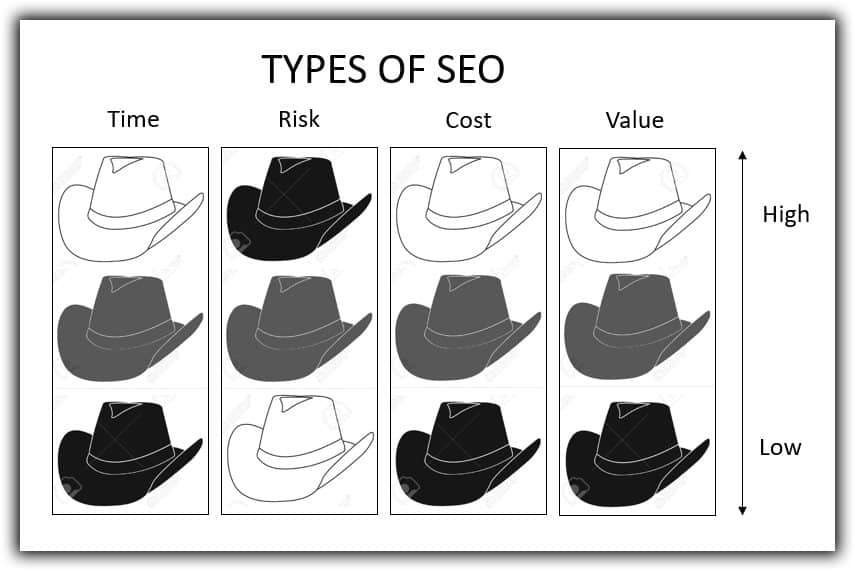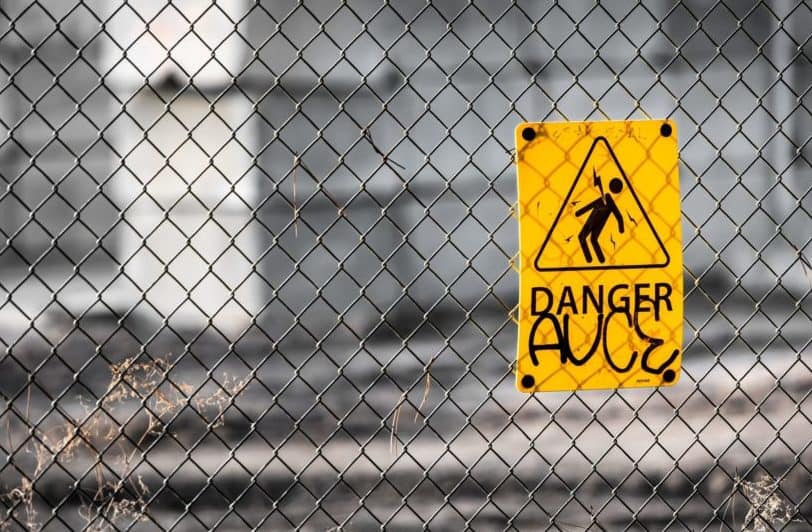Four Main Types of SEO
There are four main types of SEO or search engine optimization, all aimed at helping you earn greater visibility in search results. The main differences have to do with how closely SEO tactics align with Google guidelines and how that ultimately impacts your SEO efforts:
Black hat SEO will get you where you want to go faster. It usually costs less because you are taking shortcuts to the top by going against Google Guidelines. In fact, many black hat SEO tactics are specifically called out in the guidelines as things you should NOT do. As such, they carry the risk that your website and/or content will rank lower, be banned from search results, or demoted the next time Google updates its ranking algorithm. (More on that below.)
- White hat SEO techniques adhere to Google Webmaster Guidelines but usually take longer and cost more to implement. White hat SEO carries far less risk and tends to deliver lasting and compounding value over time. Most reputable SEO and content marketing companies use white hat SEO tools and techniques.
- Grey hat SEO falls somewhere in the middle as these tactics are not specifically called out in Google’s Guidelines. Be cautious taking this path as it is not safe to assume that just because a specific technique isn’t labeled or mentioned as being deceptive and one that will get you into trouble, that it will shield you from demotion or penalty.
- Negative SEO is the practice of implementing black or grey hat SEO techniques on someone else’s website with the intent of causing harm. Harming your competitors makes room for you to move up in search results.
Below is a quick, side-by-side comparison of the amount of time needed before you begin to see results, risks, costs, and net value associated with each type of SEO. Note that black hat SEO can typically get you to where you want to go faster and cheaper, but the value proposition can be lower as results may not be sustainable over time. Alternatively, white hat SEO offers sustained and compounding value over time, but costs more and usually takes longer to produce results.
SEO growth, regardless of your choice of strategy and tactics, is rarely swift and linear. I recommend discussing all your options with your SEO provider and, only then, make an informed decision about how best to approach achieving your goals.
Examples of Black, White, Grey Hat and Negative SEO
It’s often useful to have real life examples when something is not clear.
Examples of black hat SEO include:
- keyword stuffing or hiding (e.g. white text on white background);
- plagiarism;
- backlinks and citations that are purchased or bartered for vs earned;
- doorway pages (lots of similar pages only slightly different content);
- cloaking (where different content is shown to human and search engine visitors);
- thin content (where there is not enough content on the page to be useful); and
- private blog networks (where a group of website owners agree to cross-link to one another for the sole purpose of link building and boosting rankings).
Examples of white hat SEO include:
- writing relevant, useful content that helps your search audience do what they need to do;
- organizing the content on your site in order to help people (and search engines) find what they’re looking for faster;
- promoting your content on social media so it earns exposure and links; and
- soliciting the use of data aggregators to acquire local business citations.
Grey hat SEO involves:
- using clickbait (content whose main purpose is to attract attention and encourage visitors to click on a link to a particular web page while not delivering value);
- spun (reused and slightly altered) content;
- prolific link exchanges; and
- paying for reviews.
Negative SEO practices often focus on building unnatural or undesirable links to a competitor’s website, stealing their content, posting negative reviews, or hacking the site and modifying its content.
For a more extensive list of black hat tactics, see 44 Black Hat SEO Techniques That Will Tank Your Site from Cognitive SEO.
What are Google’s Guidelines?
So, what are Google’s Guidelines and where can you find them?
Google Webmaster Guidelines spell out what Google considers good (white hat) and bad (black hat) SEO. They are meant to help you understand what can help and hurt your rankings. While they are not laws with legal consequences, they should be taken seriously and SEOs should let clients know if they plan to step outside of the boundaries set by Google so they can assess the risks and benefits and decide for themselves what is best for their particular business.
The Guidelines are a series of online publications on Google’s support site that lay out general, basic, quality, and specific statements about what you should and should not do when designing, building, promoting, and maintaining your website. Lots of detail and examples are provided.
What Are the Risks of Going Against Google Guidelines?

The risk of a ban, demotion, or penalty for failing to comply with Google guidelines should not be taken lightly. Black hat SEO can return value quickly, but at a potentially high cost.
Don’t believe me? Here are some examples:
- In 2006, BMW was temporarily banned from search results for using “doorway” pages. Doorway pages are a black-hat technique that reuses the same content over and over again with only slight changes to game search engines and lure customers.
- The New York Times published an article about a link scheme JC Penny was using to achieve high search result rankings in 2011. Shortly thereafter, JC Penny was nowhere to found for the queries they had previously achieved top rankings for.
- Home Depot asked partners to link to their website using very specific anchor text. They also suggested the links be hidden (using white text on white background or placing the link behind an image). The result was a two-month drop from search results for many of its product pages.
- In 2013, Mozilla was penalized for hosting a web page with 12mb of spam from 21,169 user comments. While it wasn’t Mozilla’s fault, it should be a reminder to make sure you’re moderating any user-generated content on your website.
- In August 2018, the Google “Medic” algorithm update had people reporting losses of between 30 and 80 percent of their website traffic and revenue within days.
- The Daily Mail (a British newspaper) reported a 50% drop in traffic after the Google June 2019 core update. Users reported the site as having thin, low quality content as well as being “unbearably slow” and “full of ads” – all against Google guidelines.
And there are lots more examples like these. Usually they don’t surface in the newspapers, but rather in day-to-day conversation and search forums where people go to try to find help when their website traffic unexpectedly and suddenly tanks or disappears.
These incidents occur daily because Google updates its ranking algorithm daily.
What is Google’s Ranking Algorithm?

Google doesn’t rank search results manually. It’s not possible given Google handles more than 2 trillion searches a year (roughly 77,500 search queries per second) and people expect sub-second responses. Instead, Google uses a collection of automated ranking algorithms to decide who ranks where in search results. The goal is to return the best results (and quickly!).
Google wants to return outstanding search results because satisfied customers are repeat customers. Google earned more than $134 billion dollars in ad revenue last year (2019) from repeat and happy customers. They want to continue to fuel that revenue stream.
One of the many challenges Google’s faces when trying to ensure it delivers quality results, is keeping up with all the attempts to game and spam their system. To combat these ever present issues, and to continuously learn and improve, they update their ranking algorithm thousands of times per year. Updates incrementally improve search results and offset any gains made by those trying to manipulate the system and profit by it.
In 2018, Google made an incredible 3,234 algorithm updates — an average of almost 9 per day. Some of these updates were small and inconspicuous. Other (i.e. “core”) updates had a more noticeable impact.
In addition to the automated algorithm updates, Google has a dedicated Web Spam team that works with webmasters and website visitors to enforce Guidelines. You can communicate with the Google Web Spam team via the Google Webmaster Central blog, using forums, and social media.
On-Page and Off-Page SEO
While researching the different types of SEO, you might also run into the terms “on-page SEO” and “off-page SEO“. These refer to the subject of your optimization efforts and can employ any of the above described white, grey, black hat and/or negative SEO techniques.
- On-page SEO focuses on your website and content. Its aim is to ensure search engines and searchers can easily find, use, and understand your content. On-page SEO primarily helps Google and visitors decide whether your content is relevant and potentially helpful. Examples include title tags, meta tags, meta descriptions, headings, paragraphs, images, URLs, and internal as well as outgoing links.
- Off-page SEO centers on external ranking signals like backlinks and online (unlinked) mentions of your business and/or website. Assuming your content is relevant to a search query, off-page SEO mostly helps Google decide where to position it in search results. Examples include an incoming hyperlink from an external website or an unlinked mention of your company or website on social media, a website forum, a question and answer site, an online directory, or any other external website.

Comments
Post a Comment